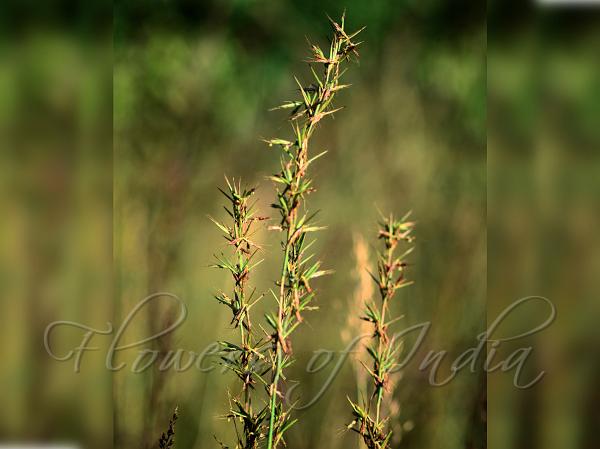|
| Palmarosa Grass |
|

|

|
|
|
|
Photo: |
Botanical name: Cymbopogon martini Family: Poaceae (Grass family)
Synonyms: Andropogon martini, Cymbopogon motia, Gymnanthelia martini
Synonyms: Andropogon martini, Cymbopogon motia, Gymnanthelia martini
Palmarosa Grass is a perennial grass which smells
sweet and rose-like. It arises from a short, stout, woody rootstock;
stems up to 3 m high, the lower nodes often swollen. Leaf-blades are
linear-lanceshaped or lanceshaped, up to 50 cm long, 10-30 mm wide,
glaucous or powdery below, usually dark green above, heart-shaped at
the base and often stem-clasping, tapering to a fillform tip. False
panicles are linear-oblong, up to 30 cm long, erect; spatheoles
narrowly elliptic to narrowly lanceshaped, 2-4 cm long, green, becoming
orange or reddish at maturity. Flower-racemes are 1.5-2.0 cm long, the
lowermost pedicle swollen and barrel-shaped; internodes and
flower-stalks denseley fringed with hairs along the margins, sparsely
hairy on the back. Sessile spikelets are elliptic-oblong or oblong,
4-4.5 mm long; lower glume flat on the back in the upper half and with
a deep V-shaped groove in the lower, the keels winged above; upper
lemma deeply bifid, with an awn 1.2-1.8 cm long. Palmarosa Grass is
found in the Himalayas till 2000 m elevations, and in Peninsular India.
Flowering: September-November.
Medicinal uses: In traditional medicine both
the plant and its oils are used to treat rheumatism, hair loss,
arthritis, lumbago and spasms. The essential oil is a strong fungicide.
In traditional medicine both
the plant and its oils are used to treat rheumatism, hair loss,
arthritis, lumbago and spasms. The essential oil is a strong fungicide.
Medicinal uses:
 In traditional medicine both
the plant and its oils are used to treat rheumatism, hair loss,
arthritis, lumbago and spasms. The essential oil is a strong fungicide.
In traditional medicine both
the plant and its oils are used to treat rheumatism, hair loss,
arthritis, lumbago and spasms. The essential oil is a strong fungicide.
| Identification credit: Ashutosh Sharma | Photographed in Hamirpur, Himachal Pradesh. |
• Is this flower misidentified? If yes,